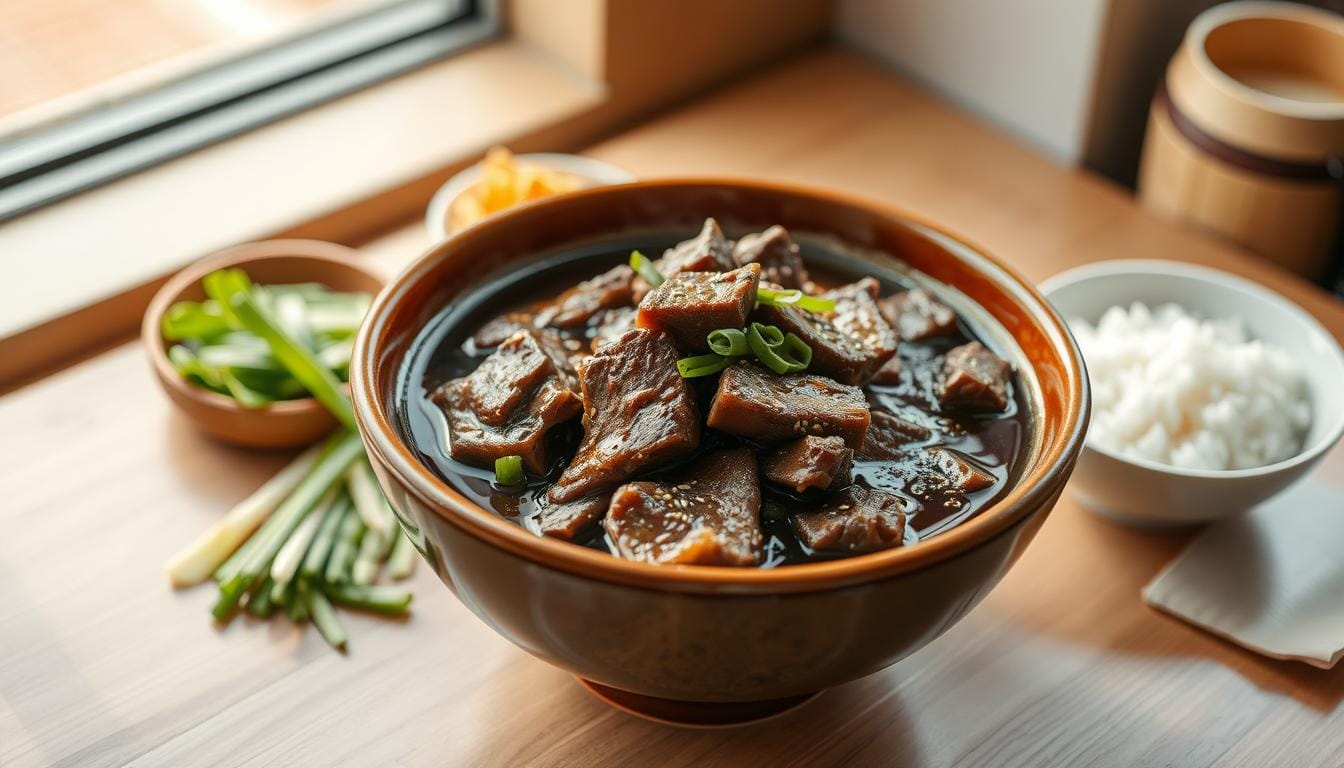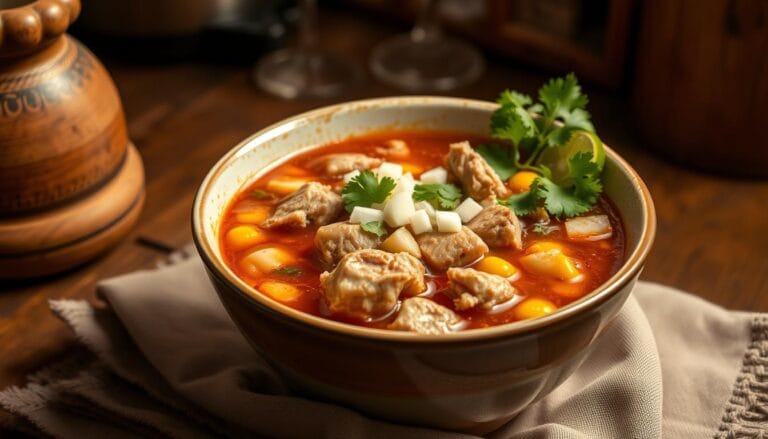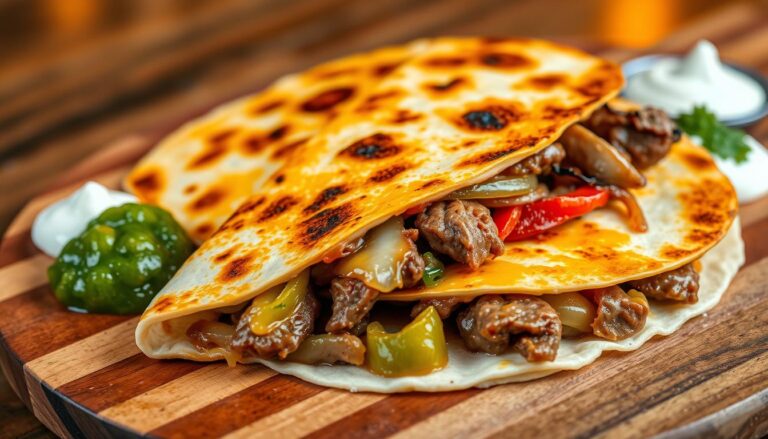How to Make Yoshinoya Beef Bowl at Home: Easy Recipe
There’s something magical about the first bite of a yoshinoya beef bowl. It’s sizzling beef in a savory-sweet sauce over fluffy rice. Whether you’ve had it at a Japanese restaurant or seen it on TV, making it at home is like unlocking a culinary secret.
Our guide makes the yoshinoya beef bowl recipe easy for beginners. You don’t need a big kitchen to make it. Imagine serving a dish as good as your favorite takeout, but made just for you and your family.
Table of Contents
Key Takeaways
- Learn the japanese beef bowl recipes secret: balancing soy sauce, mirin, and dashi for that signature umami richness.
- Discover how to slice beef properly to ensure tenderness without expensive cuts.
- Save money while achieving restaurant-quality flavors in under 30 minutes.
- Get tips for sourcing ingredients at mainstream grocery stores.
- Customize the dish with optional toppings to suit your taste.
The History and Cultural Significance of Yoshinoya Beef Bowls
Since 1899, Yoshinoya has been a key part of Japanese food culture. It started in Tokyo’s fish market as a small gyudon stall for laborers. Today, it stands as a symbol of comfort food that has lasted over a century.
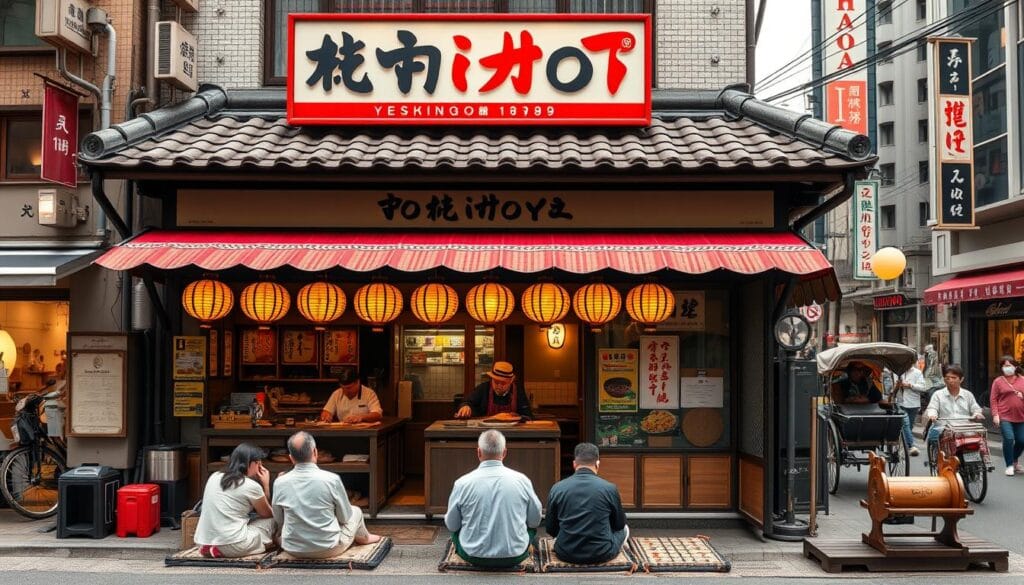
Origins of Yoshinoya in Japan
Founder Yoshiyuki Ishige introduced this dish when beef was rare in Japan. The first gyudon was thinly sliced beef in a soy sauce-based sauce. Yoshinoya survived the 1923 Great Kanto Earthquake by becoming mobile, showing its ability to adapt.
How Gyudon Became a Global Phenomenon
- Expanded to 2,000+ global locations by 2023
- Adapted to local tastes while retaining core elements
- Became a cultural ambassador for Japanese fast food
What Makes Yoshinoya’s Recipe Special
The yoshinoya beef recipe is special because of:
- Soy sauce, mirin, and dashi-based broth
- Patented “steak simmering” technique
- Use of premium Wagyu beef in original locations
These ingredients make the dish rich and flavorful, something many home cooks try to make.
“The bowl is more than food—it’s a promise of warmth.” — Yoshinoya heritage document
Knowing Yoshinoya’s history helps home cooks understand the effort behind making this famous gyudon dish.
Essential Ingredients for an Authentic Yoshinoya Beef Bowl Recipe
Making the perfect yoshinoya beef bowl recipe begins with the right ingredients. These are key to getting the flavors right in traditional japanese recipes with beef. Here’s what you need:
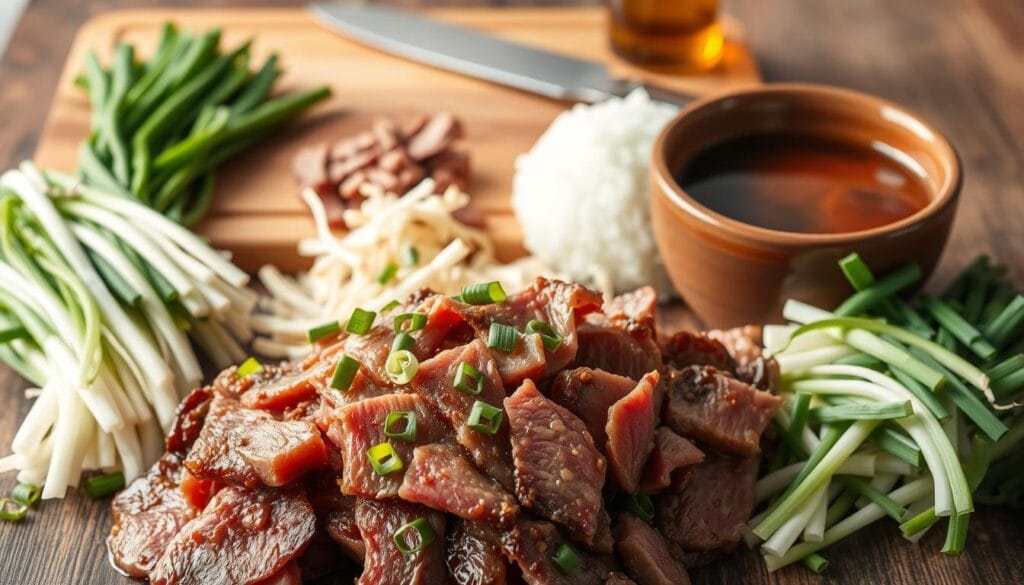
- Beef: Choose thinly sliced sirloin or ribeye for tenderness. Aim for cuts about 1/8-inch thick.
- Broth Base: Mix dashi (kelp and bonito), mirin, sake, soy sauce, and sugar. These create the savory-sweet broth.
- Onions: Slice them thinly and caramelize them. They add sweetness without overpowering the beef.
- Rice: Use Japanese short-grain rice for its sticky texture. Cook it slightly firm to avoid mushiness.
Quality matters for authenticity. Use Yamasa soy sauce and Marukome dashi granules. Maple syrup can replace mirin, but don’t use light soy sauce. It changes the salt balance. Always use fresh ginger and garlic for the best flavor.
Plan ahead for specialty items. Find kelp or mirin in Asian markets or big stores like H-Mart. Having these essentials ready ensures your yoshinoya beef bowl recipe stays true to the original, even with kitchen limitations.
Understanding Cuts of Beef for Your Japanese Beef Bowl
Mastering japanese beef bowl recipes begins with choosing the right cut. The perfect beef makes your dish tender and flavorful. Here’s how to pick, prepare, and find the best meat for your how to make yoshinoya beef meal.
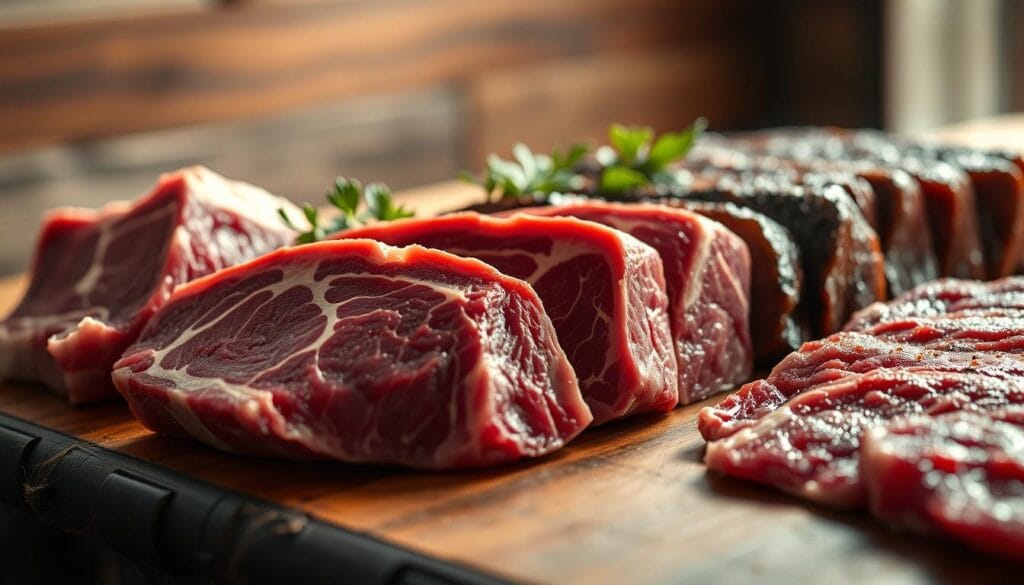
Why Thinly Sliced Beef is Critical
Thin slices (¼-inch or thinner) cook quickly in the broth. This prevents toughness and ensures even flavor. Slicing against the grain makes it even more tender, a key to how to make yoshinoya beef right.
Ribeye vs Chuck vs Sirloin Options
- Ribeye: Marbled fat adds rich flavor but is pricier. Perfect for those who love umami.
- Chuck: Affordable and tender when sliced thin. Ideal for japanese beef bowl recipes needing strong taste.
- Sirloin: Lean and firm, best if cooked briefly to avoid dryness.
Where to Find Pre-Sliced Beef in American Stores
Asian grocery chains like H-Mart or 99 Ranch Market sell pre-sliced shabu shabu or sukiyaki cuts. For DIY slicing, freeze the meat slightly for clean cuts. Ask local butchers to slice against the grain for the best results.
Kitchen Equipment You’ll Need
Learning the yoshinoya beef bowl recipe begins with the right tools. Most home kitchens already have what you need to make this dish. Let’s look at the essentials and smart alternatives.
- Heavy-Bottomed Pot or Skillet: A sturdy pan is key for even heat. Cast iron or stainless steel are best. Non-stick pans are not ideal because they can’t create fond for flavor.
- Rice Cooking Setup: A rice cooker makes perfect grains every time. If you don’t have one, a pot with a tight-fitting lid works for stovetop cooking.
- Measuring Tools: You’ll need liquid and dry measuring cups, plus precision spoons. These tools help keep the sauce’s sweet-savory balance just right.
- Sharp Chef’s Knife: A sharp knife is crucial for thin beef slices. Aim for ¼-inch slices for even cooking.
- Serving Bowls: Choose shallow, wide bowls to match Yoshinoya’s style. Ceramic or heat-safe plastic bowls are good choices.
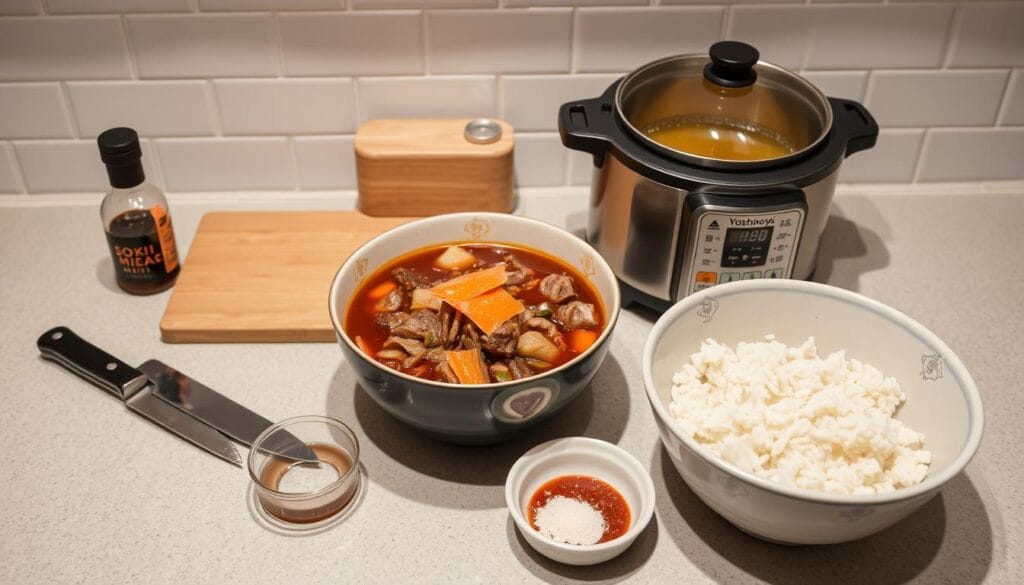
“Sharpness matters most when slicing beef. Dull blades tear meat fibers, leading to chewy results.” – Chef Hiroshi Tanaka, Japanese Cuisine Specialist
Be flexible! A cast-iron skillet can replace a Dutch oven. Use a microwave-safe bowl as a makeshift rice steamer if needed. Focus on what works, not brand names. Most home chefs already have 80% of what you need. With these basics, you’re set to make the broth and assemble the dish.
The Secret to Yoshinoya’s Signature Broth
The heart of the yoshinoya beef recipe is its broth. It’s where sweet and savory flavors come together. Mastering this mix makes your homemade gyudon as good as the restaurant kind. Let’s explore the secret behind this iconic dish.
Balancing Sweet and Savory Flavors
Getting the right mix is key. Use soy sauce, mirin, and sugar in equal parts by volume. Mirin brings brightness, and sugar balances out the salt. Adjust to taste, adding more sweetness or umami as needed.
Remember, dashi is the base of the broth. It adds a rich umami flavor. Use kombu and katsuobushi to make it. For a quick fix, dashi packets work too.
The Importance of Dashi in Your Beef Bowl
Dashi is crucial for the broth. It’s made from kombu and katsuobushi. These ingredients give a deep umami flavor without being too strong.
To make dashi, simmer kombu in water, then strain. Add bonito flakes for a minute or two. Strain again for a clear broth. Homemade dashi is better, but store-bought works too.
Substitutions for Hard-to Find Ingredients
- No dashi? Use chicken broth with a bit of fish sauce for depth.
- Mirin alternative: Mix dry sherry and sugar, or use rice wine vinegar diluted with water.
- Vegetarian dashi: Try mushroom-infused broth with konbu for a plant-based option.
These substitutions make japanese recipes with beef easier to make at home. Keeping the right ratios ensures the broth shines in your dish.
Step-by-Step Yoshinoya Beef Bowl Recipe
Learning the yoshinoya beef bowl recipe requires careful prep. Follow our steps to make it just like the restaurant in your home.
Preparing Your Ingredients
Start by cutting onions into half-moons and separating beef slices. This prevents them from sticking together. Measure out the sauce ingredients: 3 tbsp soy sauce, 2 tbsp mirin, 1 tbsp sake, 1 tbsp sugar, and 1 cup dashi. Have everything ready before you heat the pan.
Creating the Perfect Simmering Sauce
| Ingredient | Quantity |
|---|---|
| Soy sauce | 3 tablespoons |
| Mirin | 2 tablespoons |
| Sake | 1 tablespoon |
| Sugar | 1 tablespoon |
| Dashi | 1 cup |
Mix the ingredients in a pot over medium heat. Stir until the sugar melts. Then, lower the heat to keep it simmering gently. This sauce is the heart of the how to make yoshinoya beef dish.
Cooking Techniques for Tender Beef
- Heat a skillet until it’s hot, then add beef in a single layer.
- Cook for 30 seconds on each side to sear, making sure not to overcrowd the pan.
- Add the simmering sauce and cook for 2-3 minutes until the beef is just tender.
Be careful not to overcook the beef. It should still be a bit pink in the center for the best tenderness.
Assembling Your Bowl Like the Professionals
Start with 1 ½ cups of steaming rice in a bowl. Add the seared beef on top, then pour the sauce over it. Finish with a sprinkle of green onions. Serve right away to keep it warm and fresh.
How to Perfect the Rice Component
For authentic gyudon or any japanese beef bowl recipes, the rice must be fluffy yet sticky. This is key to holding sauce well. Short-grain Japanese rice is a must—it clings together and absorbs broth perfectly. Here’s how to master it:
Always wash the rice first. Rinse grains gently in cold water until the water runs clear. This removes excess starch, ensuring the rice stays separated. Over-washing can strip flavor, so stop when the water runs mostly clean.
Use a 1:1.1 water ratio for stovetop cooking. Bring water and rice to a boil, then simmer covered on low heat for 15 minutes. Let it rest 10 minutes off the heat before fluffing with a fork. For rice cookers, follow the same ratio and settings labeled for Japanese rice.
- Too mushy? Rinse longer or reduce water slightly.
- Too dry? Add a tablespoon of water next time.
Time cooking so rice finishes just as the beef simmers. Let it rest while assembling the dish—this ensures everything stays warm and melds flavors. Properly cooked rice elevates homemade gyudon to restaurant quality.
Traditional and Modern Toppings for Your Gyudon
Make your homemade gyudon special with the right toppings. Choose from classic or modern options. The right garnishes can turn your Japanese beef bowl into a memorable meal.
Classic Yoshinoya Garnishes
Begin with authentic elements:
- Beni shoga (red pickled ginger) adds a tangy kick and vibrant color.
- Thinly sliced scallions layer in fresh herb notes.
- A raw or poached egg enriches the broth—use pasteurized eggs for safety.
Creative Add-ons to Enhance Your Bowl
Try these modern upgrades:
- Pickled veggies like cucumbers or carrots add crunch and acidity.
- Season with togarashi spice blend for heat or sprinkle crispy fried onions for texture.
- Microgreens or sesame seeds boost freshness and visual appeal.
Balance toppings to enhance without overwhelming the dish’s savory base. Mix textures and flavors to craft a bowl that reflects your taste while honoring the dish’s roots.
Nutritional Breakdown and Healthier Adaptations
Start by understanding the yoshinoya beef recipe‘s nutritional profile. Our homemade version is more flexible than restaurant dishes. You can adjust ingredients to control calories and nutrients while keeping the japanese recipes with beef taste.
Calorie Comparison: Homemade vs. Restaurant Version
- Homemade: 500–600 calories (using lean beef and reduced sugar)
- Restaurant: Up to 700+ calories (due to thicker sauces and standard rice portions)
Most calories come from rice and beef fat. Swapping ingredients like sirloin for chuck meat cuts fat by 20–30%.
Low-Carb and Keto-Friendly Modifications
Make your bowl healthier with these changes:
- Substitute rice with cauliflower rice (drops carbs to 10g per serving)
- Use sugar-free soy sauce and honey alternatives in the sauce
- Opt for sirloin or flank steak to reduce saturated fats
These tweaks keep the savory umami of japanese recipes with beef while fitting dietary needs. Adjust portions to meet your goals without losing flavor.
Common Mistakes to Avoid When Making Japanese Beef Bowls
Even with the best yoshinoya beef bowl recipe, mistakes can ruin the dish. Here’s how to fix the most frequent errors:
| Mistake | Solution |
|---|---|
| Overcooking beef | Cook slices 1–2 minutes per side to stay tender |
| Sauce imbalance | Simmer broth 10–15 minutes for balanced flavors |
| Incorrect rice texture | Use short-grain rice and avoid oversteaming |
- Wrong beef cuts: Use thinly sliced ribeye or sirloin. Chuck needs marinating first.
- Rushing sauce prep: Let flavors develop by simmering ingredients fully.
- Improper portion ratios: Aim for 3:1 rice to beef ratio like restaurant portions.
Timing matters too! Prepare components in sequence so everything stays hot. Follow these tips to nail your how to make yoshinoya beef process every time.
Serving Suggestions and Complementary Side Dishes
Pairing your homemade gyudon with the right sides makes it a complete meal. Look into japanese recipes with beef that complement this iconic dish well.
Traditional Japanese Pairings
Classic sides make the gyudon even better:
- Miso Soup: Mix dashi with miso paste and silken tofu for a warm start.
- Pickled Vegetables (Tsukemono): Quick-pickled daikon or umeboshi add a tangy touch.
- Sesame Spinach: Blanch spinach, mix with sesame oil, soy sauce, and toasted seeds.
Creating a Complete Yoshinoya-Inspired Meal
Make a meal like the restaurant’s combos:
| Traditional | Modern Adaptations |
|---|---|
| Miso soup + tsukemono + green tea | Kimchi + avocado salad + barley tea |
| Soft-boiled egg (ajitsuke tamago) | Crunchy cucumber salad |
Drink hojicha or iced matcha lemonade with it. For a full spread, serve small bowls around the gyudon to match Japanese dining.
Storing and Reheating Your Homemade Beef Bowl
Learning how to store your yoshinoya beef recipe is key to enjoying leftovers. Keep the beef and sauce away from the rice to prevent it from getting soggy. Store the cooked beef and sauce in an airtight container in the fridge for 2–3 days.
If you want to keep it longer, freeze portions for up to a month. Make sure to label the containers so you know how long they’ve been in the freezer.
“Freezing the beef mixture works best when wrapped tightly to prevent freezer burn,” say professional chefs. “Always thaw overnight in the fridge before reheating.”
To reheat the beef and sauce, use low heat on the stovetop. Stir often to avoid burning. For the rice, microwave a fresh batch or leftover grains with a damp paper towel to keep it fluffy.
Never microwave the entire bowl. This can dry out the beef and overcook the rice.
- Store rice fresh daily; avoid freezing for best texture
- Label containers with dates and contents
- Use airtight containers for all components
Batch-cooking the beef sauce can save you time during busy weeknights. Portion it into family-sized servings for easy defrosting. Serve reheated beef with fresh rice and japanese beef bowl recipes toppings like pickled ginger or scallions for a restaurant-quality finish.
Comparing Your Homemade Version to Yoshinoya’s Restaurant Offering
See how your gyudon stacks up against the famous yoshinoya beef bowl recipe. Homemade versions have their own perks, even if they can’t match every detail.
Taste Test Results
- Freshness: Your dish uses ingredients cooked just before serving. This means tender beef and warm rice.
- Flavor Differences: Yoshinoya’s special broth gives a unique umami taste that’s hard to replicate at home.
- Customization: You can adjust the seasoning and toppings to your liking. This is something you can’t do at a restaurant.
Cost Savings Analysis
| Comparison Point | Homemade | Restaurant |
|---|---|---|
| Cost per serving | $3.50 | $9.95 |
| Customization | Full control | Limited choices |
| Prep time | 25 minutes | Instant takeout |
Making gyudon at home can save up to 65% per serving. Over four servings, that’s $25 saved. While the restaurant version is quick, your homemade yoshinoya beef bowl recipe lets you play with ingredients. Choose based on freshness and cost.
Conclusion
Making homemade yoshinoya beef bowl opens the door to authentic Japanese flavors. Our guide helps you choose the right beef, make a rich sauce, and get the rice just right. These steps make your dish as good as the ones in restaurants, but you can always adjust the flavors or try new things.
Don’t be afraid to add your own touches, like pickled radish or nori. Check out our guides on ramen or bento boxes for more Japanese food ideas. Your kitchen is now a place where you can explore global tastes. Start by making this classic dish and enjoy every bite.
Remember, homemade dishes can be both traditional and innovative. Keep trying new things and share your experiences with us!
FAQ
What is Yoshinoya beef bowl?
How can I make an authentic Yoshinoya beef bowl at home?
What cuts of beef work best for gyudon?
Can I substitute ingredients for the broth?
What type of rice should I use for a Yoshinoya beef bowl?
How can I enhance my gyudon with toppings?
Can I freeze leftover Yoshinoya beef bowl?
What common mistakes should I avoid when making gyudon?
How does homemade Yoshinoya beef bowl compare to the restaurant version?
Are there healthier adaptations for the beef bowl recipe?
There are no reviews yet. Be the first one to write one.

